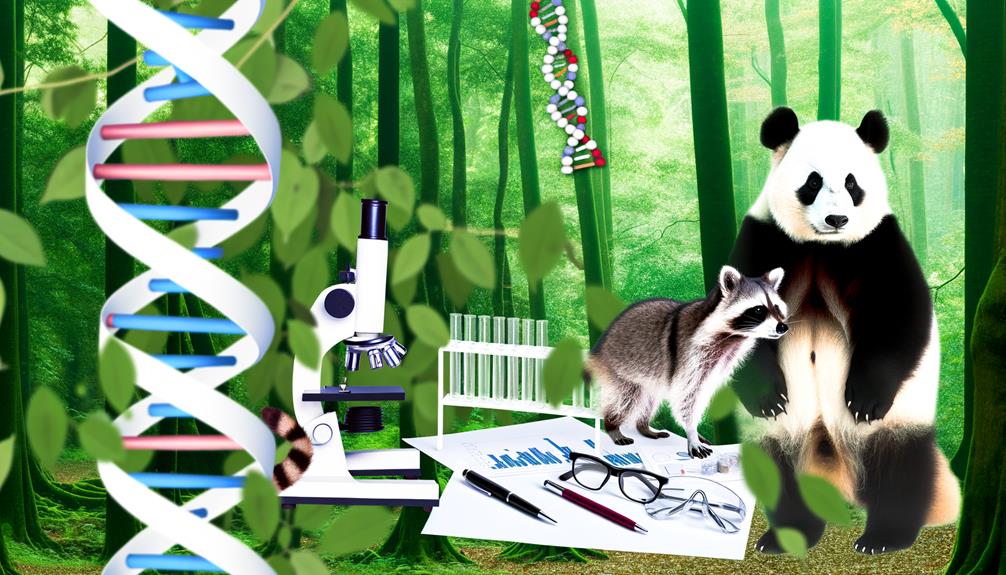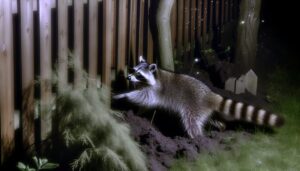Tracing Lineage – Are Panda Bears Related to Raccoons?
Panda bears and raccoons are not closely related. Panda bears belong to the family Ursidae, while raccoons are in the family Procyonidae.
Historically, morphological similarities led to misclassification, but advanced genetic studies have clarified their distinct evolutionary paths. Pandas possess unique adaptations like a pseudo-thumb and bamboo-specialized diet, whereas raccoons are highly dexterous omnivores, adaptable to varied environments.
Convergent evolution explains their superficial similarities rather than common ancestry. Intriguing nuances in their lineage and distinct behavioral traits offer fascinating insights into the evolutionary dynamics of these species.

Key Takeaways
- Giant pandas are more closely related to bears (family Ursidae), not raccoons.
- Raccoons belong to a different family, Procyonidae, confirming distinct evolutionary paths.
- Genetic studies reveal significant divergence between panda bears and raccoons.
- Historical classification errors were due to phenotypic similarities, not genetic kinship.
- Convergent evolution explains shared traits, but pandas and raccoons are not closely related.
Evolutionary Background

The evolutionary background of panda bears (Ailuropoda melanoleuca) and raccoons (Procyon lotor) reveals distinct phylogenetic paths despite some convergent morphological traits.
Panda bears belong to the family Ursidae, which places them within the order Carnivora, closely related to other bear species. Raccoons, conversely, are part of the family Procyonidae, also within Carnivora but diverging notably in their evolutionary lineage.
Molecular phylogenetics, particularly mitochondrial and nuclear DNA analyses, have confirmed these taxonomic distinctions.
Despite their superficial similarities, such as a shared masked facial appearance and dexterous forelimbs, these traits are products of convergent evolution rather than common ancestry.
This evidence underscores the importance of genetic data in elucidating evolutionary relationships, distinguishing phenotypic convergence from true phylogenetic kinship.
Panda Bear Characteristics
Renowned for their distinctive black-and-white coloration, panda bears exhibit several unique morphological and physiological traits adapted for their mainly bamboo-based diet. Ailuropoda melanoleuca, the giant panda, possesses a pseudo-thumb, an enlarged wrist bone that aids in grasping bamboo. Their robust molars and powerful jaw muscles facilitate the mastication of fibrous plant material. Additionally, pandas have a highly specialized digestive system, including a relatively short gut for a herbivore, relying heavily on gut microbiota to break down cellulose.
| Feature | Description |
|---|---|
| Pseudo-thumb | Enlarged wrist bone for grasping |
| Robust molars | Facilitate mastication of bamboo |
| Digestive system | Specialized, short gut, relies on microbiota |
These adaptations underscore the giant panda's evolutionary divergence from other Ursidae members, driven by dietary specialization.
Raccoon Traits

Procyon lotor, commonly known as the raccoon, displays a versatile array of morphological and behavioral traits that have enabled its successful adaptation to diverse environments. These omnivorous mammals are characterized by their dexterous forepaws and masked facial markings, features that contribute to their ecological versatility.
Raccoons exhibit nocturnal behaviors and are proficient climbers, allowing them to exploit a variety of ecological niches.
- Dietary Flexibility: Omnivorous, consuming fruits, insects, small mammals, and human refuse.
- Dexterous Forepaws: Highly sensitive, enabling manipulation of objects and food.
- Nocturnal Activity: Primarily active at night, reducing competition with diurnal species.
- Masked Facial Markings: Potentially aids in visual communication and camouflage.
- Climbing Ability: Adapted to arboreal and terrestrial habitats, enhancing foraging opportunities.
These traits collectively underscore the raccoon's adaptive success in both urban and wild settings.
Early Classification Efforts
Early taxonomic efforts frequently resulted in misclassifications, with giant pandas initially grouped with raccoons due to superficial morphological similarities. Advances in molecular techniques and a more inclusive fossil record have since provided critical insights that refined these classifications.
Such evidence underscores the importance of integrating genetic data and paleontological findings in resolving phylogenetic relationships.
Misclassifications in Early Taxonomy
The early taxonomic efforts to classify panda bears and raccoons were fraught with misclassifications due to superficial morphological similarities. These initial errors arose because early taxonomists relied heavily on phenotypic characteristics without the benefit of genetic analysis. Consequently, both the giant panda (Ailuropoda melanoleuca) and the raccoon (Procyon lotor) were mistakenly grouped together.
- Phenotypic Similarities: Both species exhibit similar facial markings and dexterous forelimbs.
- Convergent Evolution: Analogous traits were mistaken for common ancestry.
- Lack of Genetic Tools: Early taxonomists lacked DNA analysis technologies.
- Misleading Dietary Habits: Both species have omnivorous diets, leading to incorrect associations.
- Taxonomic Revisions: Subsequent genetic studies clarified their distinct evolutionary lineages.
These misclassifications underscore the importance of integrating molecular data in modern taxonomy.
Fossil Record Insights
However, the fossil record provides additional insights into the early classification efforts of panda bears and raccoons, revealing the complexities of their evolutionary histories.
The discovery of Ailuridae fossils, an extinct family closely related to both pandas and raccoons, has been pivotal. These fossils exhibit morphological traits that are intermediate between the Ursidae (bear family) and Procyonidae (raccoon family), complicating early taxonomic classifications.
For instance, the genus *Parailurus* shares characteristics with both pandas and raccoons, leading to initial taxonomic ambiguities.
Additionally, the phylogenetic analysis of the Miocene epoch's fossil specimens has elucidated the divergent evolutionary paths of these species.
Therefore, these fossil records underscore the intricate evolutionary lineage and assist in resolving historical classification dilemmas.
Genetic Studies and Findings

Recent advancements in genetic studies have provided critical insights into the taxonomic relationships between panda bears (Ailuropoda melanoleuca) and raccoons (Procyon lotor).
DNA sequence comparisons reveal significant genetic divergence, highlighting distinct evolutionary pathways.
These findings underscore the necessity of reevaluating traditional classification methods through robust evolutionary lineage analysis.
DNA Sequence Comparisons
Intriguingly, comparative DNA sequence analyses have elucidated the phylogenetic relationships between panda bears (Ailuropoda melanoleuca) and raccoons (Procyon lotor), revealing significant evolutionary divergences. Genetic studies have shown that despite superficial morphological similarities, panda bears share closer genetic ties with the family Ursidae (bears) than with Procyonidae (raccoons).
Key findings from the DNA sequence comparisons include:
- Ailuropoda melanoleuca exhibits greater genome similarity with other Ursidae members.
- Molecular markers indicate distinct evolutionary branches.
- Mitochondrial DNA sequences provide evidence for separate lineage divergence.
- Nuclear DNA analyses reinforce the separation between Ursidae and Procyonidae.
- Comparative genomics highlight functional gene differences pertinent to dietary and ecological adaptations.
These genetic insights underscore the profound evolutionary separation between these two species.
Evolutionary Lineage Analysis
Thorough genetic analyses have elucidated the distinct evolutionary trajectories of Ailuropoda melanoleuca and Procyon lotor, underscoring their divergent phylogenetic pathways. Genomic sequencing reveals that the giant panda belongs to the family Ursidae, sharing common ancestors with other bears, whereas the raccoon is part of the family Procyonidae. These findings are substantiated by molecular phylogenetics, which highlight significant genetic divergence approximately 48 million years ago.
| Species | Family | Evolutionary Divergence (MYA) |
|---|---|---|
| Ailuropoda melanoleuca | Ursidae | 48 |
| Procyon lotor | Procyonidae | 48 |
| Common Ancestor | – | 48 |
This tabulated data underscores the phylogenetic separation, affirming that despite some phenotypic similarities, pandas and raccoons are not closely related.
Dietary Habits Comparison
The dietary habits of panda bears (*Ailuropoda melanoleuca*) and raccoons (*Procyon lotor*) exhibit significant differences, primarily due to their distinct evolutionary adaptations and ecological niches.
Panda bears are obligate herbivores with a diet predominantly consisting of bamboo, which comprises over 99% of their intake. These dietary distinctions are reflective of their morphological and physiological adaptations.
- Panda Bears:
- Primarily consume bamboo
- Specialized molar teeth for grinding plant material
- Enlarged wrist bone functioning as a thumb
- Low metabolic rate
- High dependency on specific bamboo species
Raccoons, on the other hand, are omnivores exhibiting a diverse diet that includes fruits, insects, small vertebrates, and human refuse. Their dietary habits reflect their ecological niche and evolutionary adaptations.
- Raccoons:
- Omnivorous diet
- Versatile foragers
- Dexterous front paws
- Opportunistic feeding behavior
- High adaptability to various food sources
Habitat and Behavior

While dietary habits highlight the distinct adaptations of panda bears and raccoons, their respective habitats and behaviors further underscore their unique ecological roles. Panda bears (Ailuropoda melanoleuca) inhabit mainly the temperate forests of central China, relying on bamboo groves and exhibiting sedentary behavior. Conversely, raccoons (Procyon lotor) thrive in various environments, ranging from North American woodlands to urban areas, showcasing remarkable adaptability and nocturnal activity patterns.
| Species | Habitat | Behavior |
|---|---|---|
| Panda Bear | Temperate forests, China | Sedentary, bamboo-reliant |
| Raccoon | North American woodlands, urban | Nocturnal, adaptable |
Such distinctions in habitat and behavior, influenced by distinct evolutionary pressures, reflect the divergent ecological niches occupied by these taxa, highlighting their unique evolutionary paths.
Common Misconceptions
Despite widespread public awareness, numerous misconceptions persist about the biology and ecology of panda bears (Ailuropoda melanoleuca) and raccoons (Procyon lotor). These misconceptions often arise from superficial similarities and outdated classifications. Clarifying these misunderstandings is essential for accurate scientific communication.
- Taxonomic Confusion: Historically, giant pandas were mistakenly grouped with raccoons.
- Dietary Habits: Pandas are mainly herbivorous, consuming almost exclusively bamboo, while raccoons are omnivorous.
- Behavioral Traits: Pandas exhibit solitary behavior, whereas raccoons are more communal and often live in urban areas.
- Morphological Differences: Pandas have a unique pseudo-thumb for bamboo manipulation; raccoons lack this feature.
- Habitat Preferences: Panda bears inhabit mountainous bamboo forests in China, in contrast to raccoons' adaptability to various environments.
Scientific Consensus

Recent advancements in genetic and morphological studies have solidified the distinct taxonomic classifications of panda bears and raccoons within the scientific community. Molecular analyses, including mitochondrial DNA sequencing, reveal that the giant panda (Ailuropoda melanoleuca) is more closely related to bears (family Ursidae), while raccoons (Procyon lotor) belong to the family Procyonidae.
Morphological characteristics, such as dental patterns and cranial structures, further corroborate these findings. The red panda (Ailurus fulgens), once thought to be closely related to both groups, is now placed in its own unique family, Ailuridae, based on detailed phylogenetic studies.
Consequently, current scientific consensus confirms that pandas and raccoons, despite superficial similarities, are distinct evolutionary lineages within the order Carnivora.
Conclusion
While early classification efforts placed giant pandas with raccoons due to superficial similarities, genetic studies have firmly established giant pandas within the Ursidae family, distinct from raccoons.
This dichotomy is akin to mistaking a distant cousin for a sibling based solely on appearance. Both species showcase convergent evolution in dietary habits and certain physical traits, yet their genetic divergence underscores the complexity of classifying biodiversity.
Scientific consensus now accurately reflects these evolutionary pathways.






